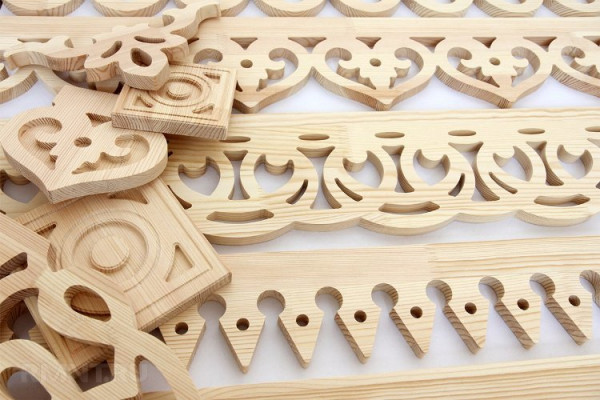Types of wood carving. How to make carved products on CNC machines. Models for different threads.

Wood carving is an ancient art that has been used for a long time to decorate various household items, interior and exterior.
Wood is a flexible, inexpensive, and accessible material, so it is not surprising that different products were created from it in different countries and at different times.
A few facts from history:
It is known that ethnic peoples were the first to try wood carving. For example, African tribes created figurines and masks. The Indians used it to make canoes and totem poles.
Much later, in medieval and Gothic times in Europe, churches and cathedrals were decorated with beautiful carvings. Even later, carved furniture in the Rococo style and carved picture frames became popular.
Carving also flourished in folk art of the 20th century.
Not all wood products have survived to this day, because despite the fact that hardwoods are pleasing to the eye for at least 80-100 years, wood will not live for centuries (unlike stone).
Nevertheless, the fact remains that in all cultures and among all peoples this was a favorite way of decorating their homes and public buildings.
With the help of carving, they created idols, objects for rituals, and household items from wood; they decorated the roofs and shutters of houses; they produced furniture and decor. Skilled carvers were worth their weight in gold.
In Russia, from time immemorial, spinning wheels, ladles, spindles, dishes and spoons have been decorated with carvings. House carving flourished in the 19th century. Peasant houses were decorated with openwork carvings and resembled fairy-tale houses.
Nowadays, wood carvings are increasingly being created using numerically controlled machines. Nevertheless, the types of carving used are the same ones that were invented many years ago by master carvers who did everything by hand.
Kinds:
There are several types of carving. The main ones are:
- Flat-notched
- Flat-relief
- Welted (openwork)
- Embossed
- Sculptural
Let's talk about each type in a little more detail.
Flat thread:
Flat socket carving is formed as follows: recesses and grooves are cut into flat wood to form a pattern. This method is used to decorate dishes, doors, trim, and furniture facades. A type of flat carving is geometric wood carving (when the design is created using simple geometric shapes).
Examples of stl models for flat-notch threads on a CNC machine are presented in the sections:
- 2d panels
- 2d baguette
- 2d decor vertical, horizontal, central
- 2d facades.
Flat relief carving:
This type of carving, unlike flat carving, assumes that all other material will be removed, and the pattern will be formed by sampling the background around it. The height of the picture in this case is the same over the entire area of the composition. This option is one of the most common.
There are certain requirements for 3D models that will be used for flat-relief carving. For example, the background should not be too small. The center lines should not be too wide.
Slotted thread:
It is a type of flat-relief carving, but the background is completely cut through. This type of carving is also called openwork. Can be used independently or in combination with flat-relief carving (which allows you to create an interesting decorative effect). In some cases, decor carved using openwork carvings is placed in a frame with a flat base. The result is an analogue of flat-relief carving.
Slotted carving is used to create a wide variety of elements. The most striking example is openwork decorative partitions and beautiful railings.
The requirements for 3D models in this case will be the following - the lines should not be too thin or protruding, as chipping may occur during cutting.
In addition, there are artistic and compositional nuances for flat-relief carving (regular and slotted); it is advisable to ensure the presence of a certain composition, rhythm and consistency. All lines usually alternate correctly and logically.
Relief carving:
In this case, the drawing will be three-dimensional, three-dimensional, it protrudes high above the surface of the tree (different elements can be located at different heights). The result is a very unusual product. Shadows appear in the recesses. Products designed in this way invariably evoke admiration and look like real works of art.
A striking example of 3d models for CNC machines is in the section 3d panel models. And also in the sections baguette models, door models, watch models.
Sculptural:
The most complex type of carving. The final product is figurines in the form of sculptures. Or parts from which furniture is subsequently assembled (legs, backs, handles, drawers of unusual shape with original lush 3-dimensional decor).
Using 3D Models for CNC, you can cut out animals, birds, human figures, characters, chess pieces, vases, balusters, pillars and columns from wood and much more.
Manufacturing:
Today, any type of carving can be realized on a material with detailed accuracy in the shortest possible time using CNC machines.
And the best helpers in this actually become 3D models. Our website presents a huge assortment, including a variety of models of future products for any style, industry and purpose.
In addition, there is always the possibility of modifying any of the presented models according to your order, depending on the type of thread you need, as well as making custom models according to your drawings, sketches, pictures from the Internet.
Our models are distinguished by favorable prices and the highest quality; people work with us and trust us.



